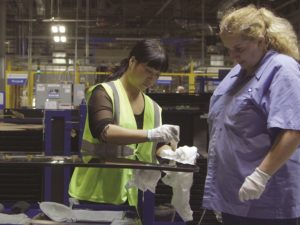Goodbye, Wendy Darling, Tiger Lily, and Tinkerbell. In Benh Zeitlin’s Wendy, a fantasy riff on J.M. Barrie’s iconic literary creation, Peter Pan, the restlessness of young Wendy (Devin France), a girl who lives above her mom’s New Orleans diner with her twin brothers, James and Douglas (Gavin and Gage Naquin), is the driving force of the story. From her bedroom window late one night, Wendy espies Peter (Yashua Mack), a Caribbean imp with dreads, dancing atop a train, and she follows him — with her brothers tagging along — to an island with an active volcano (shot on Montserrat). Their existential journey more closely resembles Maurice Sendak’s Where the Wild Things Are and Zeitlin’s previous film, Beasts of the Southern Wild, than Barrie’s adventures in Neverland, popularized by the ’50s Disney animated feature and Broadway musical.

Wendy (which opened in theaters in February and is now streaming and on disk) is a dream project of Zeitlin’s — he grew up in New York City and its suburbs with parents who were folklorists. The surprise success of Beasts, which took its nonprofessional African-American cast from the bayous of Louisiana to the grand prize at Sundance and Oscar nominations, was due largely to its wondrous visuals and its exotic characters and performances. The plot was flimsy and undercooked, but audiences were too distracted by the movie’s sparkling junk-heap aesthetic to care.
In Wendy, which Zeitlin wrote with his sister, Eliza, those plot issues pose more of a problem. Peter’s island is powered by volcanic bursts and a massive, glowing serpent he calls Mother — he regards her as the source of his fantasy powers and ability not to grow up. Zeitlin’s Wendy is attracted to Peter but not dominated by him; she’s not interested in perpetual childhood and rebellion, and instead seeks to define herself between the comforts of motherhood and the desire to live, sing, and dance with abandon. Despite the movie’s various meta-twists (on Captain Hook’s genesis and the process of aging), Zeitlin is focused on Wendy’s feminist self-actualization, for which Peter and the Lost Boys serve merely as a disappointing contrast. If only the rapturous style of his filmmaking were rooted in more structured storytelling.
The first movie from Michelle and Barack Obama’s production company, Higher Ground, is the Oscar-winning documentary American Factory, a stunningly fair-minded and sober look at the state of manufacturing in the industrial heartland. Directed by Steven Bognar and Julia Reichert (and available for streaming only on Netflix), it follows the conversion of a defunct General Motors plant in Dayton, Ohio, into a sleek new factory of the Chinese auto-glass company Fuyao. The cultural and political conflicts between the Chinese management and the Americans, who want the venture to succeed but bristle at the wages and conditions imposed on them, are stark. When the United Auto Workers attempts to unionize the plant, frustrations on both sides reach a boiling point.

Bognar and Reichert are old hands at making muckraking documentaries, but their work here is startling mostly for the seemingly limitless access they have — to everyone from Fuyao chairman Cao Dewang to the men and women who work the floor — and for the clarity and gravitas of their filmmaking. They shoot in the cinema verité style of fly-on-the-wall observation, peppered with voice-overs by the Americans as we see them work, which come across like internal monologues. Embarrassing statements and rah-rah militaristic pep talk by Chinese managers abound, yet the company continues, unabashed, to tighten its grip around the Americans. The final reckoning comes in the inevitable introduction of more robots, and the sense of despair mounts among the workers, who are earning a third of what unionized automotive jobs paid less than a decade earlier.
Though women are absent from executive ranks, they are well represented on the factory floor, and their concerns are front and center. But even in the context of Chinese and blue-collar norms, sexism is not the focus of contention: it’s all about the nature of work and a living wage.
The throttling of women’s lives is merely the backdrop of Céline Sciamma’s rigorous and poignant lesbian romance, Portrait of a Lady on Fire. Sciamma is a bright light in contemporary queer cinema, from her brilliant character study of a proto-trans child, Tomboy, to the streetwise Girlhood, set among black girl gangs in Paris. Portrait, now available for streaming and on disk, is her first period piece, set on the coast of Brittany in the late 18th century. A young woman who has left a convent, Héloïse (Adèle Haenel), is being set up for marriage with a Milanese gentleman. A portrait painter is hired to create an image of the potential bride. And so, Marianne (Noémie Merlant) arrives, an independent-minded artist who ends up falling in love with her subject.

The bleak, wintry countryside and rocky beach are both beautiful and forbidding, as is the world of privilege in which the women function. Sciamma accumulates key details — a servant needing an abortion; a dress catching fire — that symbolize the path of desire and societal dead-ends they must confront. The magisterial pace of scenes, and the exquisite restraint and simplicity of the production, imagery, and performances, only heighten the movie’s potency.
It’s hard to remain unmoved by this film. Despite Sciamma’s modern point of view, her vision of the past feels grounded in truth, and the ending is more wistful than tragic. Like Marianne’s portrait, it’s about the ambivalent emotions generated by art, not politics.



